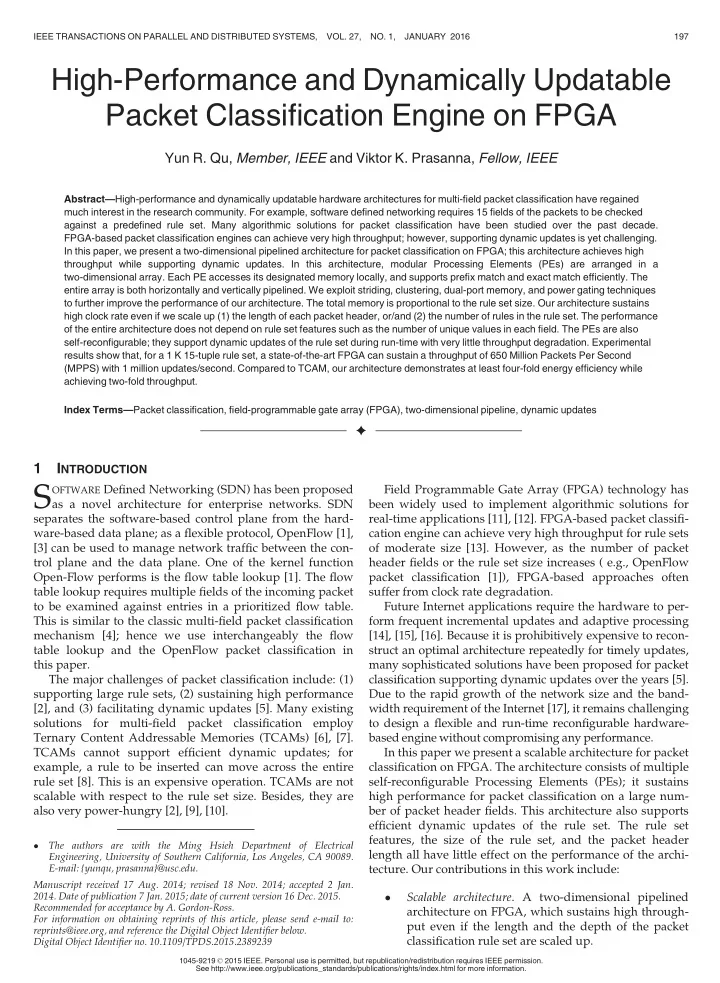

IEEE TRANSACTIONS ON PARALLEL AND DISTRIBUTED SYSTEMS, VOL. 27, NO. 1, JANUARY 2016 197 High-Performance and Dynamically Updatable Packet Classification Engine on FPGA Yun R. Qu, Member, IEEE and Viktor K. Prasanna, Fellow, IEEE Abstract— High-performance and dynamically updatable hardware architectures for multi-field packet classification have regained much interest in the research community. For example, software defined networking requires 15 fields of the packets to be checked against a predefined rule set. Many algorithmic solutions for packet classification have been studied over the past decade. FPGA-based packet classification engines can achieve very high throughput; however, supporting dynamic updates is yet challenging. In this paper, we present a two-dimensional pipelined architecture for packet classification on FPGA; this architecture achieves high throughput while supporting dynamic updates. In this architecture, modular Processing Elements (PEs) are arranged in a two-dimensional array. Each PE accesses its designated memory locally, and supports prefix match and exact match efficiently. The entire array is both horizontally and vertically pipelined. We exploit striding, clustering, dual-port memory, and power gating techniques to further improve the performance of our architecture. The total memory is proportional to the rule set size. Our architecture sustains high clock rate even if we scale up (1) the length of each packet header, or/and (2) the number of rules in the rule set. The performance of the entire architecture does not depend on rule set features such as the number of unique values in each field. The PEs are also self-reconfigurable; they support dynamic updates of the rule set during run-time with very little throughput degradation. Experimental results show that, for a 1 K 15-tuple rule set, a state-of-the-art FPGA can sustain a throughput of 650 Million Packets Per Second (MPPS) with 1 million updates/second. Compared to TCAM, our architecture demonstrates at least four-fold energy efficiency while achieving two-fold throughput. Index Terms— Packet classification, field-programmable gate array (FPGA), two-dimensional pipeline, dynamic updates Ç 1 I NTRODUCTION S OFTWARE Defined Networking (SDN) has been proposed Field Programmable Gate Array (FPGA) technology has as a novel architecture for enterprise networks. SDN been widely used to implement algorithmic solutions for separates the software-based control plane from the hard- real-time applications [11], [12]. FPGA-based packet classifi- ware-based data plane; as a flexible protocol, OpenFlow [1], cation engine can achieve very high throughput for rule sets [3] can be used to manage network traffic between the con- of moderate size [13]. However, as the number of packet trol plane and the data plane. One of the kernel function header fields or the rule set size increases ( e.g., OpenFlow Open-Flow performs is the flow table lookup [1]. The flow packet classification [1]), FPGA-based approaches often table lookup requires multiple fields of the incoming packet suffer from clock rate degradation. to be examined against entries in a prioritized flow table. Future Internet applications require the hardware to per- This is similar to the classic multi-field packet classification form frequent incremental updates and adaptive processing mechanism [4]; hence we use interchangeably the flow [14], [15], [16]. Because it is prohibitively expensive to recon- table lookup and the OpenFlow packet classification in struct an optimal architecture repeatedly for timely updates, this paper. many sophisticated solutions have been proposed for packet The major challenges of packet classification include: (1) classification supporting dynamic updates over the years [5]. supporting large rule sets, (2) sustaining high performance Due to the rapid growth of the network size and the band- [2], and (3) facilitating dynamic updates [5]. Many existing width requirement of the Internet [17], it remains challenging solutions for multi-field packet classification employ to design a flexible and run-time reconfigurable hardware- Ternary Content Addressable Memories (TCAMs) [6], [7]. based engine without compromising any performance. TCAMs cannot support efficient dynamic updates; for In this paper we present a scalable architecture for packet example, a rule to be inserted can move across the entire classification on FPGA. The architecture consists of multiple rule set [8]. This is an expensive operation. TCAMs are not self-reconfigurable Processing Elements (PEs); it sustains scalable with respect to the rule set size. Besides, they are high performance for packet classification on a large num- also very power-hungry [2], [9], [10]. ber of packet header fields. This architecture also supports efficient dynamic updates of the rule set. The rule set features, the size of the rule set, and the packet header � The authors are with the Ming Hsieh Department of Electrical length all have little effect on the performance of the archi- Engineering, University of Southern California, Los Angeles, CA 90089. E-mail: {yunqu, prasanna}@usc.edu. tecture. Our contributions in this work include: Manuscript received 17 Aug. 2014; revised 18 Nov. 2014; accepted 2 Jan. 2014. Date of publication 7 Jan. 2015; date of current version 16 Dec. 2015. � Scalable architecture . A two-dimensional pipelined Recommended for acceptance by A. Gordon-Ross. architecture on FPGA, which sustains high through- For information on obtaining reprints of this article, please send e-mail to: put even if the length and the depth of the packet reprints@ieee.org, and reference the Digital Object Identifier below. classification rule set are scaled up. Digital Object Identifier no. 10.1109/TPDS.2015.2389239 1045-9219 � 2015 IEEE. Personal use is permitted, but republication/redistribution requires IEEE permission. See http://www.ieee.org/publications_standards/publications/rights/index.html for more information.
Recommend
More recommend